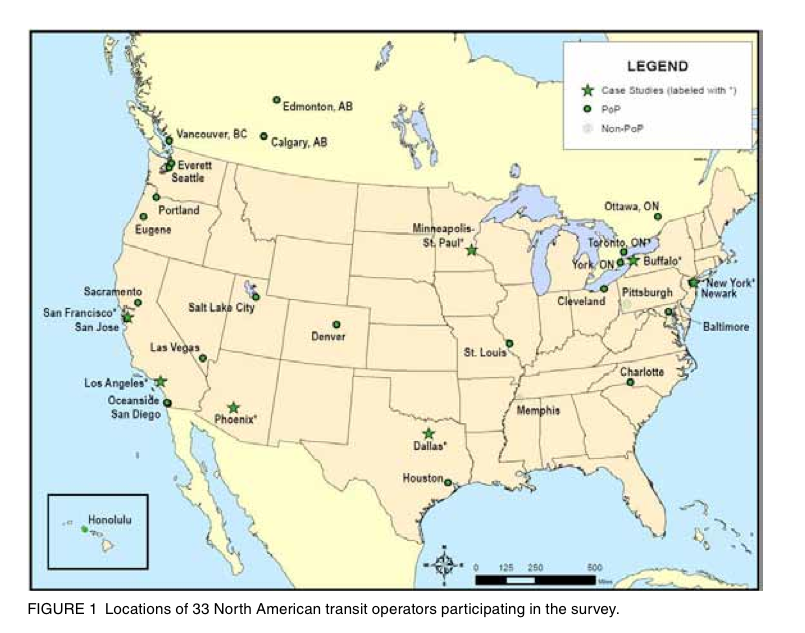TRANSIT COOPERATIVE RESEARCH PROGRAM
Introduction
PROOF-OF-PAYMENT FARE COLLECTION IN NORTH AMERICA
Off-board proof-of-payment (PoP) fare collection is a relatively recent application in North America. Typically, the majority of PoP operations require a transit customer to purchase fare media off-board the transit vehicle. For instance, purchase could be at a ticket vending machine (TVM) on a station platform, via the Internet, or at a retail outlet. With a valid ticket or pass in hand, the customer is permitted to board the transit vehicle through any door. The customer does not have to show the proof-of-payment to the driver, and there are no conductors on board.
As a result, enforcement of fare payment through inspection is a necessary function of PoP to ensure fare compliance. The enforcement relies on fare enforcement/inspection personnel who randomly ask riders to show proof-of-payment. Passengers unable to do so may be issued citations imposing a fine as a deterrent to fare evasion.
PoP fare collection is also referred to as self-service, barrier-free (SSBF) fare collection and sometimes as the “honor system.” For purposes of this study, the focus is on off-board fare payment and PoP fare verification. For con- sistency and simplicity, “PoP” is used throughout this report to represent the broader subject of self-service and stations with or without barriers. A common component is the need for enforcement to verify that passengers possess valid fare payment. As for the term “honor system,” strictly defined, it involves no PoP verification, that is, no enforcement, and is not employed by any transit operators in North America.
PoP fare collection had its North American beginnings with SeaBus ferry services in Vancouver, British Columbia. However, the introduction of PoP on ground transit services began with the start of Edmonton and Calgary, Alberta, and San Diego, California, light rail transit (LRT) services in 1978–1981. Edmonton LRT, which initiated service in 1978, actually did not use PoP fare collection until 1980. Calgary and San Diego LRT services followed in succession in 1981 with use of PoP from the start of revenue service in each case.
From those beginnings, PoP has essentially become the standard fare collection method on subsequently developed North American LRT lines. Over these 30-plus years, there have been many changes to how PoP fare collection has been carried out. Comparison of transit operators employing PoP will uncover many variations in operating practices and adjudication procedures. The emergence of smart cards for basic fare media has made it more convenient for riders to pay their fares but, at the same time, has added a challenge for operators with respect to effective enforcement of fare payment.
In addition to the LRT experiences, in recent years, PoP has been extended to other transit modes: regular bus, bus rapid transit (BRT), heavy rail transit (HRT), modern streetcars, and commuter rail (CR).
Read full report (PDF) here: Off-Board Fare Payment Using Proof-of-Payment Verification
About the TCRP
www.trb.org/TCRP
“The Transit Cooperative Research Program (TCRP) is an applied, contract research program that develops near-term, practical solutions to problems facing transit agencies.”







 RSS Feed
RSS Feed